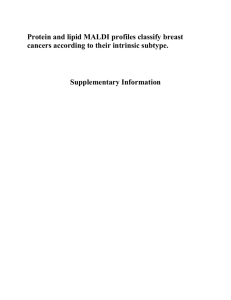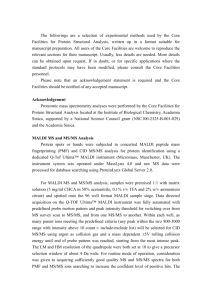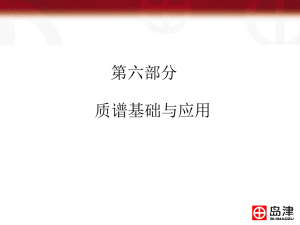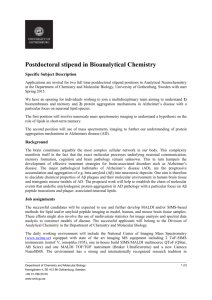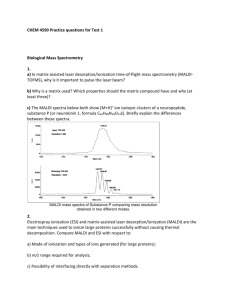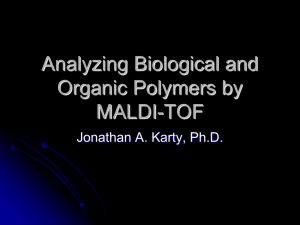MALDI Mass Spectrometry Facility - Schulich School of Medicine
advertisement
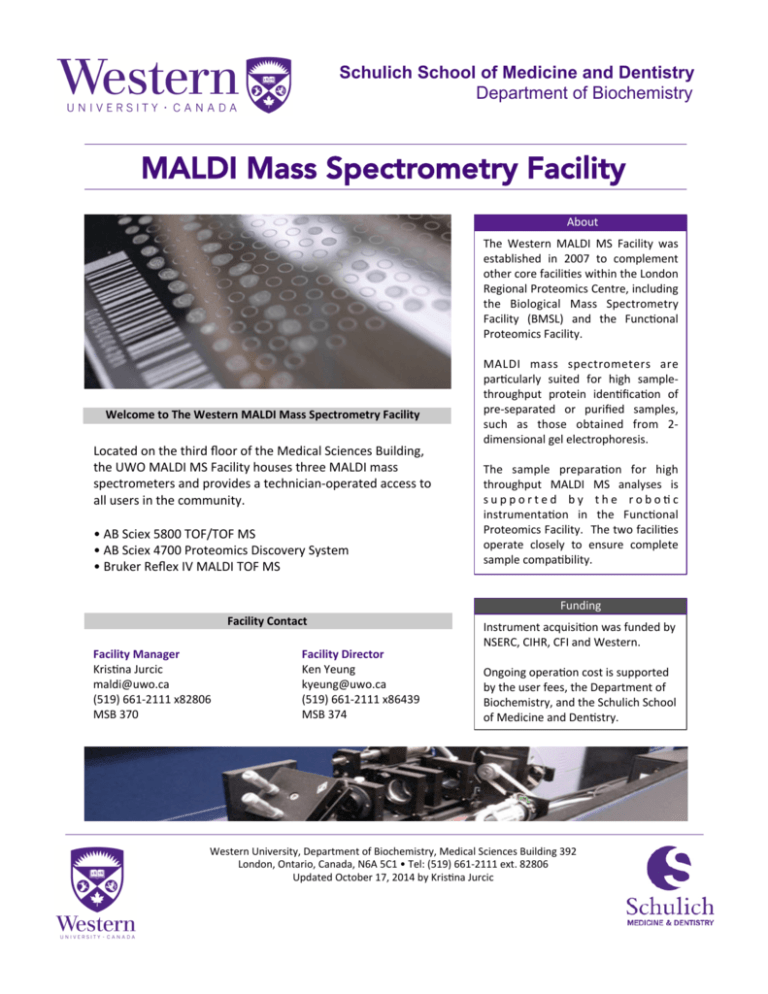
Schulich School of Medicine and Dentistry Department of Biochemistry MALDI Mass Spectrometry Facility About Welcome to The Western MALDI Mass Spectrometry Facility Located on the third floor of the Medical Sciences Building, the UWO MALDI MS Facility houses three MALDI mass spectrometers and provides a technician-­‐operated access to all users in the community. • AB Sciex 5800 TOF/TOF MS • AB Sciex 4700 Proteomics Discovery System • Bruker Reflex IV MALDI TOF MS The Western MALDI MS Facility was established in 2007 to complement other core faciliUes within the London Regional Proteomics Centre, including the Biological Mass Spectrometry Facility (BMSL) and the FuncUonal Proteomics Facility. MALDI mass spectrometers are parUcularly suited for high sample-­‐ throughput protein idenUficaUon of pre-­‐separated or purified samples, such as those obtained from 2-­‐ dimensional gel electrophoresis. The sample preparaUon for high throughput MALDI MS analyses is s u p p o r t e d b y t h e r o b o U c instrumentaUon in the FuncUonal Proteomics Facility. The two faciliUes operate closely to ensure complete sample compaUbility. Funding Facility Contact Facility Manager KrisUna Jurcic maldi@uwo.ca (519) 661-­‐2111 x82806 MSB 370 Facility Director Ken Yeung kyeung@uwo.ca (519) 661-­‐2111 x86439 MSB 374 Instrument acquisiUon was funded by NSERC, CIHR, CFI and Western. Ongoing operaUon cost is supported by the user fees, the Department of Biochemistry, and the Schulich School of Medicine and DenUstry. Western University, Department of Biochemistry, Medical Sciences Building 392 London, Ontario, Canada, N6A 5C1 • Tel: (519) 661-­‐2111 ext. 82806 Updated October 17, 2014 by KrisUna Jurcic Schulich School of Medicine and Dentistry Department of Biochemistry MALDI Mass Spectrometry Facility Instruments About AB SCIEX TOF/TOF 5800 System The system's fast data acquisiUon speed and low agomole sensiUvity offer great depth of sequence coverage for confident protein detecUon in complex mixtures, making it an ideal plaiorm for gel spot analysis and biomarker discovery. The 5800 System is also capable of MALDI mass spectrometry imaging (MSI) of Ussue. It provides a high sensiUvity MS and MS/MS data on small molecules as well as pepUdes and proteins in Ussues. The new MALDI source self-­‐cleaning capabiliUes overcome the drawbacks of the system contaminaUon from Ussue samples and significantly increase system up-­‐ Ume and producUvity. The instrument was funded by the Schulich School of Medicine and DenUstry and research grants from users including NSERC Discovery Grant, CIHR OperaUng Grant, and CIHR Team Grant on Vascular CogniUve impairment. AB Sciex 4700 Proteomics Discovery System The 4700 Proteomics Discovery System is based on a MALDI tandem Ume-­‐of-­‐flight mass spectrometer with TOF/TOF opUcs. In addiUonal to idenUficaUon by pepUde fingerprinUng in the MS mode, this instrument can perform parUal pepUde sequencing of selected precursor ions aker collision-­‐induced dissociaUon in the MS/MS mode. This feature is extremely useful in improving the confidence in database searches, as well as idenUficaUon of post-­‐translaUonal modificaUons. The typical work flow of this system is opUmized for proteomics research, parUcularly in delivering automated MS and MS/MS analyses at high sample throughput. This instrument is funded by UWO Academic Development Fund to Dr. Ken Yeung and the Department of Biochemistry. Bruker Reflex IV Matrix Assisted Laser DesorpNon IonizaNon-­‐Time of Flight Mass Spectrometer The Bruker Reflex IV is a research grade MALDI TOF instrument equipped with a linear/ reflectron mass analyzer and post-­‐source decay (PSD) capability. The built-­‐in high resoluUon view finder allows users to search for “sweet-­‐spot” in the sample, and thus enables ultra sensiUve analysis at agomole level for pepUdes and femtomole level for proteins. The extended mass range linear detector provides enhanced sensiUvity up to m/z of 300,000. The mass resoluUon in reflectron mode is > 20,000. This instrument was funded through a CFI New OpportuniUes grant to Dr. Ken Yeung. Western University, Department of Biochemistry, Medical Sciences Building 392 London, Ontario, Canada, N6A 5C1 • Tel: (519) 661-­‐2111 ext. 82806 Updated October 17, 2014 by KrisUna Jurcic Schulich School of Medicine and Dentistry Department of Biochemistry MALDI Mass Spectrometry Facility About User Fee Rate MS and MS/MS Service1 Instrument Ume* Sample/Report PreparaUon MS Imaging Service2 Scan Ume** Sample/Report PreparaUon Internal (SSMD) $90/hr $45/hr $45/hr $45/hr Internal (UWO) $110/hr $45/hr $65/hr $45/hr External $170/hr $50/hr $120/hr $50/hr Rates effecNve October 1, 2014. *half hour minimum for all rates ** addiUonal $45 charged for instrument calibraUon AddiUonal notes: For first-­‐Ume internal users, a complimentary MS analysis of two samples is available For a high volume of samples, a discount is available Refer to the following page for descripNon of MS, MS/MS and MS imaging services Western University, Department of Biochemistry, Medical Sciences Building 392 London, Ontario, Canada, N6A 5C1 • Tel: (519) 661-­‐2111 ext. 82806 Updated October 17, 2014 by KrisUna Jurcic Schulich School of Medicine and Dentistry Department of Biochemistry MALDI Mass Spectrometry Facility User Fee Rate About 1/ MS and MS/MS Service Instrument Ume refers to the laser Ume (instrument warm up and operaUon). Sample/report preparaUon refers to sample sporng, de-­‐salUng, and comprehensive data interpretaUon. Users performing their sample sporng and data analysis pay only the instrument Ume. Examples: MS analysis of 5-­‐8 samples at good quality (purity and concentraUon): 0.5 hr for instrument calibraUon and sample analysis 0.5 hr for sample sporng MS/MS analysis: CalibraUon of MS/MS mode requires 1 hr 1 minute to perform MS/MS scan of 1-­‐2 precursors (5 samples x 2 trials x 5 precursors each = 50 -­‐ 100 minutes) 2/ MS Imaging Service The scanning Ume includes profiling prior to serng up the imaging experiment and image acquisiUon. Instrument calibraUon is mandatory and charged as 0.5 h instrument Ume. Tools for Ussue preparaUon and matrix applicaUon are available. MS imaging of ganglioside GM1c18 on rat brain Ussue. Decreased expression of GM1c18 was observed in the stroke region (right side). Western University, Department of Biochemistry, Medical Sciences Building 392 London, Ontario, Canada, N6A 5C1 • Tel: (519) 661-­‐2111 ext. 82806 Updated October 17, 2014 by KrisUna Jurcic Schulich School of Medicine and Dentistry Department of Biochemistry MALDI Mass Spectrometry Facility About InformaNon for External Users Example of Fees Typical MALDI MS analysis of 5 samples costs $135. This includes half hour for sample preparaUon ($25), half hour for the instrument Ume ($85), and half hour for data analysis/sample report ($25). Samples in gel require addiUonal sample preparaUon ($145). Processing of these samples is done in the FuncUonal Proteomics Facility and it includes roboUc protein spot/band picking, automated in-­‐gel enzymaUc digesUon and pepUde extracUon, and lyophilizaUon. For more informaUon, contact us or refer to the materials posted by the UWO FuncUonal Proteomics Facility. Sample Packaging Lyophilized: ambient temperature; overnight shipping preferred In soluNon: on dry ice; overnight shipping In gel: place in a sealed bag in 2% aceUc acid; overnight shipping preferred Shipping Samples can be shipped by the choice of a courier when pre-­‐paid by the users. AlternaUvely, shipping via Purolator/FedEx can be charged to our Facility account. The shipping fees will be billed later to the users together with the analysis fee. Please contact the Facility Manager for shipping arrangements. Western University, Department of Biochemistry, Medical Sciences Building 392 London, Ontario, Canada, N6A 5C1 • Tel: (519) 661-­‐2111 ext. 82806 Updated October 17, 2014 by KrisUna Jurcic Schulich School of Medicine and Dentistry Department of Biochemistry MALDI Mass Spectrometry Facility Facility Policies About Access and ReservaNons The MALDI MS is open from 9:00am to 5:00pm on weekdays when the University is open. Users are encouraged to make reservaUons on instrument Ume with the Facility Manager with one-­‐day noUce. Users requiring access to the facility aker hours must make prior arrangements with the Facility Manager. ResponsibiliNes of Users and their Supervisors First and foremost, users should not agempt to use any instrumentaUon without the appropriate training or advice from the Facility Manager. Adequate training will ensure safe usage of the equipment and limit misuse. Log books are provided for each mass spectrometers. Please use the log book to note any problems or concerns. In the event of a major issue with any instrument, contact the Facility Manager immediately. In the event of instrument damage due to abuse, misuse, or unauthorized use, the research supervisor will be held financially responsible for the cost of repair or replacement. Data and Computer Maintenance Users are strongly encouraged to backup their data soon aker acquisiUon. Due to limited storage capacity, hard drives need to be cleaned off regularly, and the facility will not be held responsible for loss of any data files. InstallaUon of programs onto the facility computers is strictly prohibited. Contact the Facility Manger if you feel that the computer is lacking a criUcal program. Finally, each computer in the facility is set up with parameters specific to the programs that it is running, thus users are asked not to change any computer or program serngs not related to their own experiments. Billing The facility will charge access fees in order to cover the cost of consumables and instrument operaUng costs as defined in the fee structure. Users must provide a valid speed code for invoicing prior to equipment use. Billing will be invoiced semi-­‐annually and a copy of the invoice will be sent to the research supervisor electronically. Western University, Department of Biochemistry, Medical Sciences Building 392 London, Ontario, Canada, N6A 5C1 • Tel: (519) 661-­‐2111 ext. 82806 Updated October 17, 2014 by KrisUna Jurcic Schulich School of Medicine and Dentistry Department of Biochemistry MALDI Mass Spectrometry Facility Sample PreparaNon Protocols PepNde samples should be dissolved in water or 10% ACN, 0.1% TFA, containing minimum background (see table). Protein samples should be prepared in water or 2 mM ammonium bicarbonate. The sample is mixed at 1:1 raUo with the matrix and spoged onto MALDI target (spot vol. 0.75 µL). About Component or condiNon pH NaOH Urea Guanidine HCl Dithiothreitol (DTT) NaCl, KCl Ammonium carbonate Tris HEPES, MOPS Phosphate buffer Glycerol Detergents, non-­‐ionic Sodium dodecyl sulfate (SDS) Octyl-­‐b-­‐D-­‐glucopyranoside Octyl glucoside acid Dimethylsulfoxide (DMSO) Sodium azide Pyridine Coomassie blue stain Maximum < 4 50 mM 1 – 2 M 1 – 2 M 0.5 M (50 – 100) mM (100 – 500) mM 50 mM (50 – 100) mM (10 – 20) mM 1 % 0.1 % 0.01 % 0.1 % 50 mM (avoid) 1 mM 0.05 % 0.01 % Common MALDI matrices α-­‐Cyano-­‐4-­‐hydroxycinnamic acid (CHCA) CHCA is the most common matrix used for basic and neutral proteins and pepUdes. It is prepared as 5mg/mL in 50% ACN, 50% water, and 0.1% TFA. AlternaUvely, instead of water, 25mM ammonium citrate or 6mM ammonium phosphate monobasic can be used to suppress matrix signals. 2,5-­‐Dihydroxybenzoic acid (DHB) DHB is used for acidic and phosphorylated pepUdes. It can also be used for organic molecules (carbohydrates, syntheUc polymers). It is prepared as 20mg/mL in 15mM ammonium citrate, 20% ethanol, a 1% phosphoric acid. Sinapinic acid (SA) SA is generally used for high protein masses (>20kDa). However, it is parUcularly appropriate for highly acidic and phosphorylated proteins. It is prepared as 5mg/mL in 50% ACN, 50% water, and 0.15% TFA. AlternaUvely, 25mM ammonium citrate is used instead of water. Specialty MALDI matrices 2,4,6-­‐trihydroxyacetophenone (THAP) -­‐ for low mass oligonucleoUdes (5000Da) 2-­‐(4'-­‐hydroxybenzeneazo) benzoic acid (HABA) – for polymer and dendrimer 5-­‐chloro-­‐2-­‐mercaptobenzothiazole (CMBT) and 1,5-­‐diaminonapthalene (DAN) -­‐ for ganglioside imaging T-­‐2-­‐(3-­‐(4-­‐t-­‐Butyl-­‐phenyl)-­‐2-­‐methyl-­‐2-­‐propenylide) malononitrile (DCTB) -­‐ for fullerene derivaUves Dithranol and trans-­‐3-­‐indoleacrylic -­‐ for polymer analysis Western University, Department of Biochemistry, Medical Sciences Building 392 London, Ontario, Canada, N6A 5C1 • Tel: (519) 661-­‐2111 ext. 82806 Updated October 17, 2014 by KrisUna Jurcic Schulich School of Medicine and Dentistry Department of Biochemistry MALDI Mass Spectrometry Facility Useful Links for MALDI MUS seful Links MALDI MS MASCOT -­‐ a powerful search engine that uses mass spectrometry data to idenUfy proteins from primary sequence databases hgp://www.matrixscience.com/search_form_select.html Compute pI/MW tool -­‐ calculate pI and MW of pepUde, by ExPASy hgp://web.expasy.org/compute_pi/ ProteinProspector -­‐ proteomics tools for mining sequence databases in conjucUon with mass spectrometric experiments. hgp://prospector.ucsf.edu/prospector/mshome.htm MALDI matrices -­‐ list of MALDI matrices by Sigma-­‐Aldrich hgp://www.sigmaaldrich.com/analyUcal-­‐chromatography/analyUcal-­‐products.html? TablePage=103431784 Department of Chemistry Mass Spectrometry Facility hgps://www.uwo.ca/chem/resources/faciliUes/mass_spectrometry/index.htm Western University, Department of Biochemistry, Medical Sciences Building 392 London, Ontario, Canada, N6A 5C1 • Tel: (519) 661-­‐2111 ext. 82806 Updated October 17, 2014 by KrisUna Jurcic
